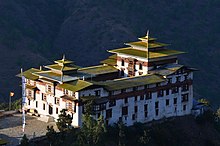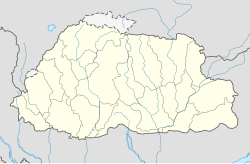Trashigang Dzong (Dzongkha: བཀྲ་ཤིས་སྒང་རྫོང, literally "The Fortress of the Auspicious Hill") is one of the largest dzong fortresses in Bhutan, located in Trashigang in Trashigang District of Bhutan. The fortress was built in 1659 to defend against Tibetan invasions. The dzong hosted a monastic community besides acting as the central administrative center of the Trashigang District, before they were shifted due to the ongoing restoration.[1][2][3][4]
| Trashigang Dzong | |
|---|---|
 Trashigang Dzong | |
| Religion | |
| Affiliation | Tibetan Buddhism |
| Festivals | Trashigang Tshechu |
| Location | |
| Location | Trashigang, Trashigang District, Bhutan |
| Country | Bhutan |
| Geographic coordinates | 27°20′12.6″N 91°33′05.2″E / 27.336833°N 91.551444°E |
| Architecture | |
| Style | Dzong |
History
editThe fortress was built in 1659 atop a ledge with steep cliffs on three sides, overlooking the Drangme Chhu and Gamri Chhu rivers. The construction of the dzong was prophesied by Ngawang Namgyal who ordered the Penlop (Governor) of Trongsa, Chhogyal Minjur Tempa to put down local chieftains and construct the dzong.[3] According to legend, the sight of the Dzong scared the Tibetan army which retreated while remarking that the Dzong was a "Sky Dzong and was not on the ground". The dzong was further expanded by Gyalsey Tenzin Rabgye between 1680 and 1694 and by Dzongpon Dopola in 1936. The dzong was consecrated and named as Trashigang by Dudjom Jigdral Yeshe Dorje. After the 1962 Sino-Indian War, Bhutan allowed Indian soldiers returning home to pass through Eastern Bhutan. However they were required to deposit their rifles at the armoury in the Dzong, and proceed through Bhutan unarmed. The rifles lie in the Dzong to this day. The dzong celebrates the four day long Trashigang Tshechu festival every year, with around 1500 people attending the celebrations on each day.[1][5][6][7][8]
Conservation
editThe dzong developed wide cracks as a result of the 2009 Bhutan earthquake, whose epicenter was 10 miles (16 km) away from the dzong.[2] A partnership between World Monuments Fund, Prince Claus Fund and the Bhutan Foundation was instrumental for assistance in emergency repairs at the dzong. In February 2014, the Government of India allotted Nu.190 million for renovating the dzong. The renovation works are expected to be completed by June 2018, while the costs have risen to Nu.227.5 million. A drasha (monk hostel) for 50 monks, besides a tshokhang (dining area) are built outside the dzong's premises for safety and health reasons. The government is also recruiting local unemployed youth to construct the dzong, and will be using locally sourced materials in the construction, including timber mostly from Bumthang and stones from Chazam. The Trashigang district administrative offices have been temporarily relocated to the Trashigang Middle Secondary School while the clergy were moved to a school in Samkhar Gewog, about 10 km away from the dzong.[2][7][9][10]
Gallery
editReferences
edit- ^ a b "Trashigang". Bhutan Tourism. Archived from the original on 18 November 2016. Retrieved 30 April 2017.
- ^ a b c "Trashigang Dzong". World Monuments Fund. Archived from the original on 17 March 2017. Retrieved 30 April 2017.
- ^ a b "Trashigang Dzong". Druk Air. Retrieved 30 April 2017.
- ^ "Dzong renovation makes steady progress". Kuensel. Archived from the original on 15 February 2016. Retrieved 4 May 2017.
- ^ "Will you be attending the Monggar and Trashigang Tshechus in Bhutan, this year?". Daily News and Analysis. Mumbai. Archived from the original on 25 April 2015. Retrieved 30 April 2017.
- ^ "Good turnout at Trashigang Tshechu". Kuensel. Thimphu, Bhutan. Archived from the original on 27 January 2016. Retrieved 4 May 2017.
- ^ a b "Renovating Trashigang dzong". Kuensel. Thimphu, Bhutan (Archive of the original, hosted by the Indian Embassy). Retrieved 4 May 2017.
- ^ "The crossroads at the Doklam plateau". The Hindu. Retrieved 26 July 2017.
- ^ "Conservation of T'gang Dzong on track". Kuensel. Thimphu, Bhutan. Retrieved 4 May 2017.
- ^ "Unemployed youth to build dzongs". Kuensel. Thimphu, Bhutan. Archived from the original on 30 May 2016. Retrieved 4 May 2017.
